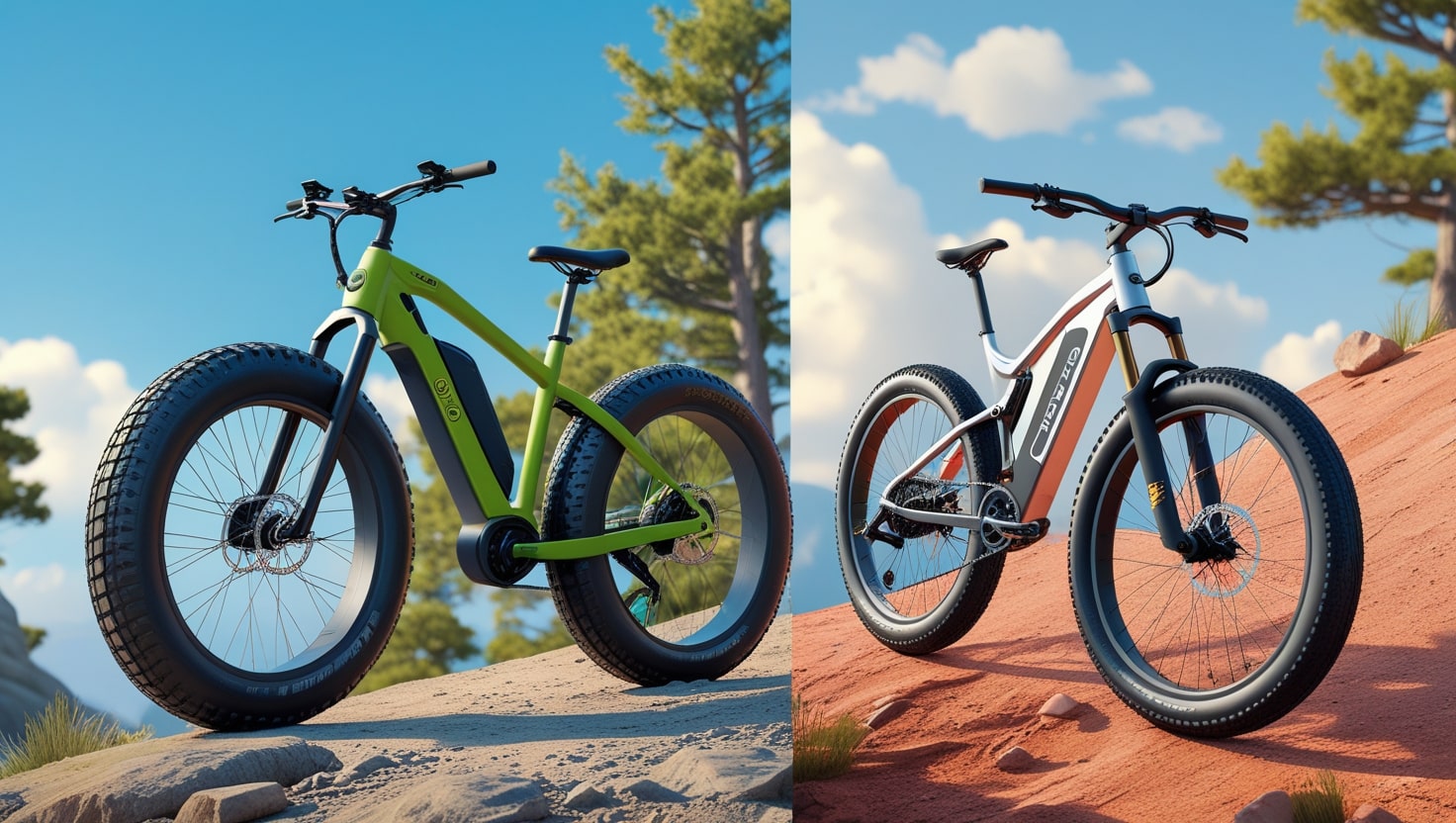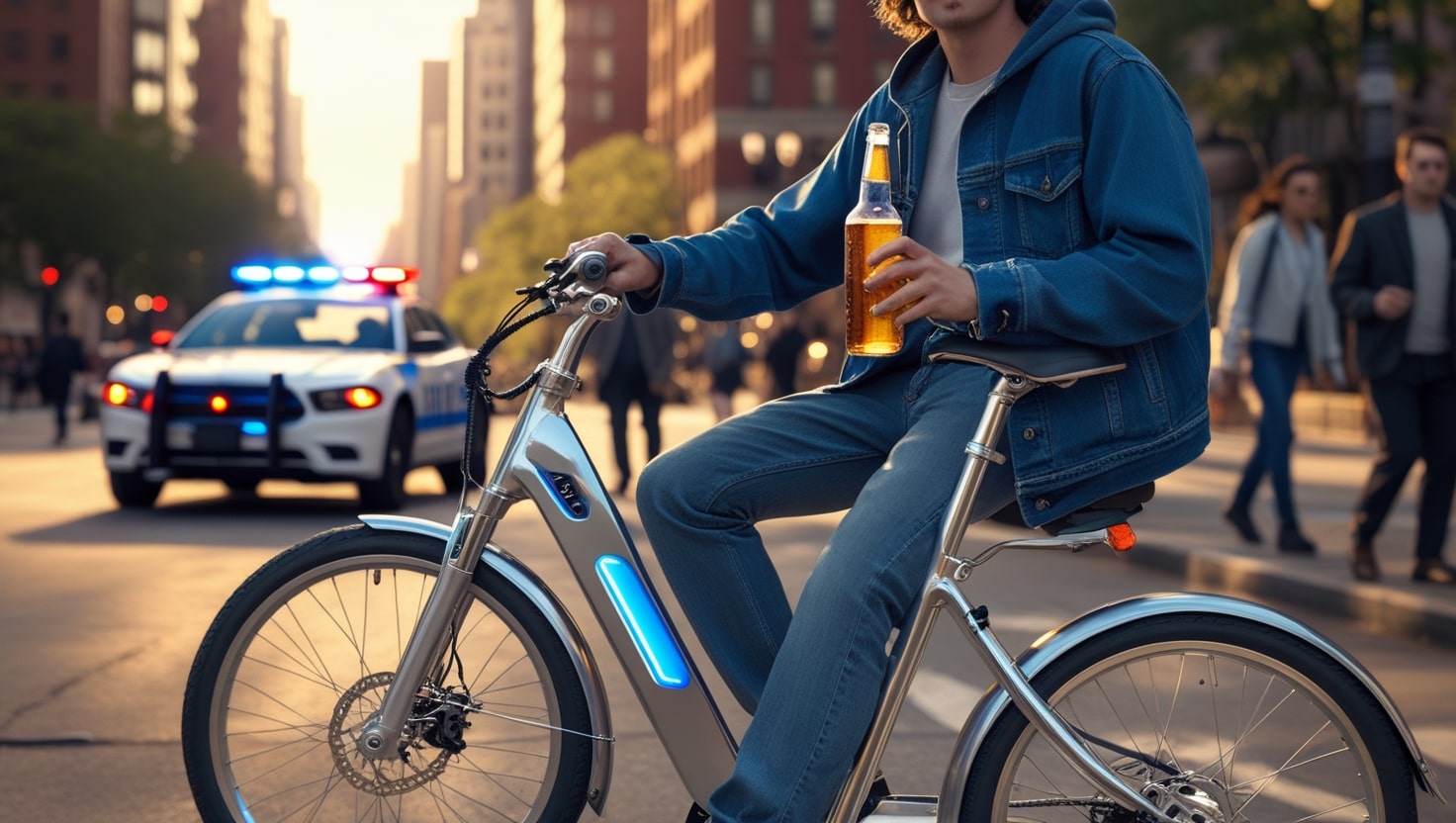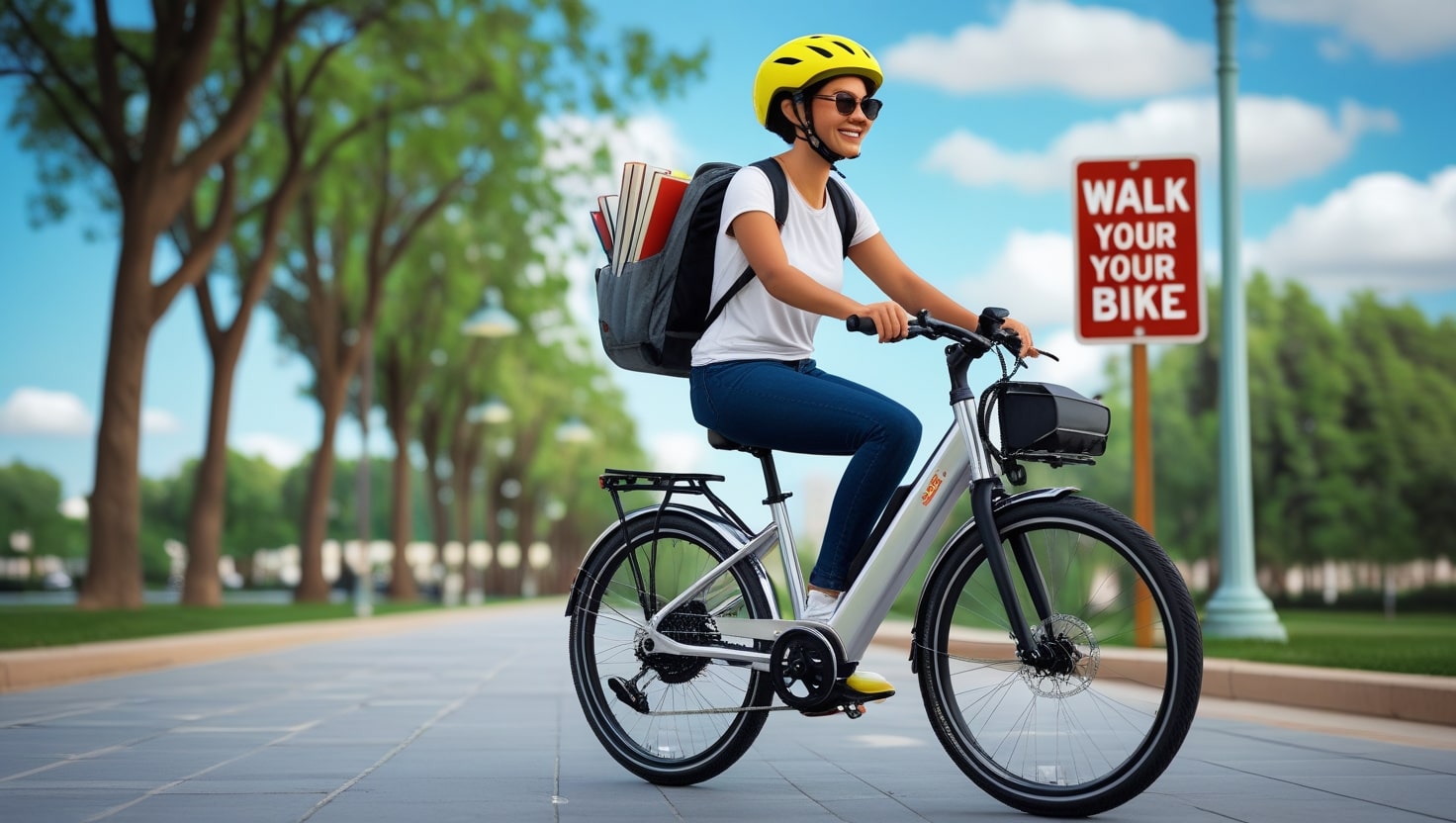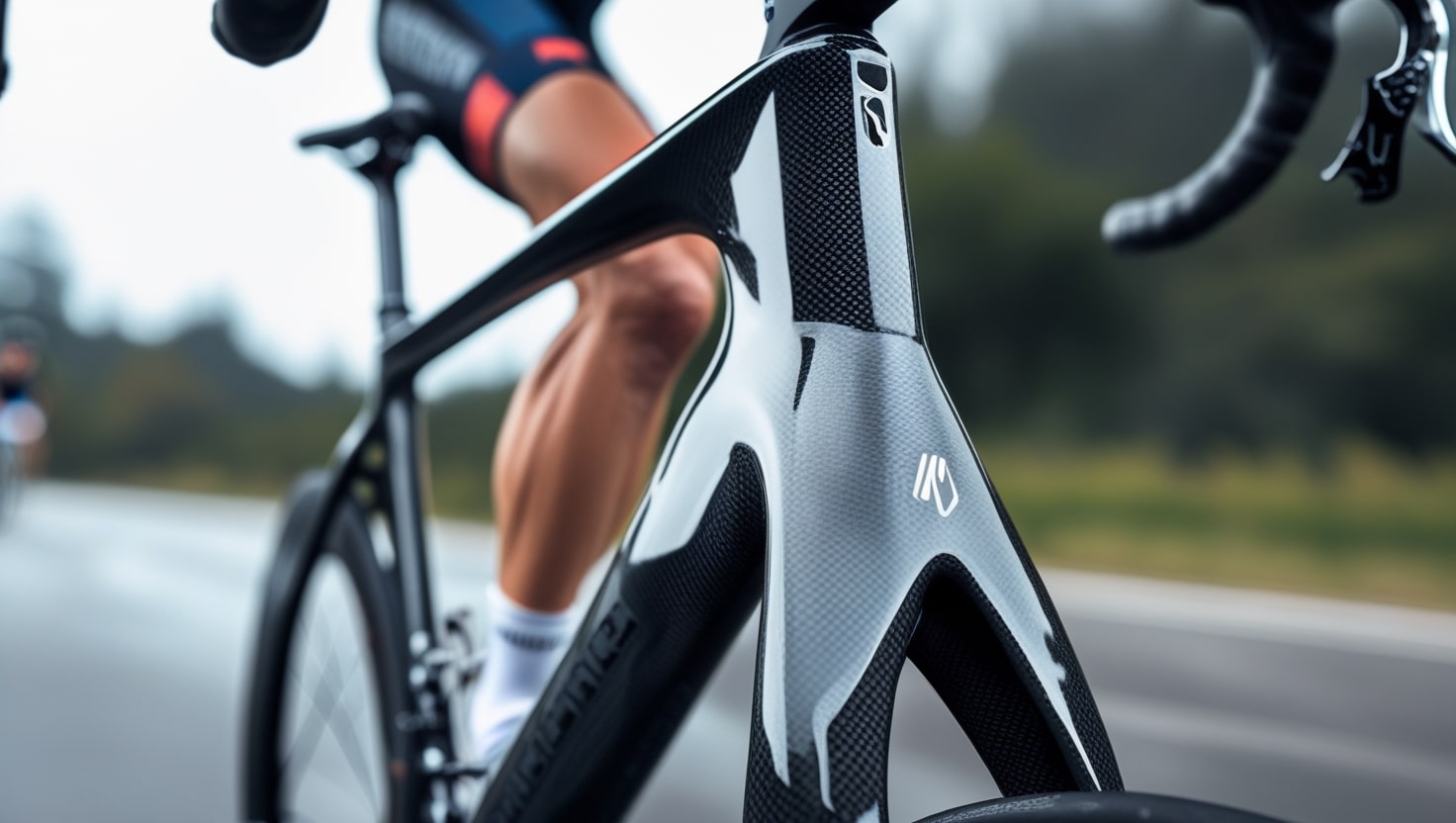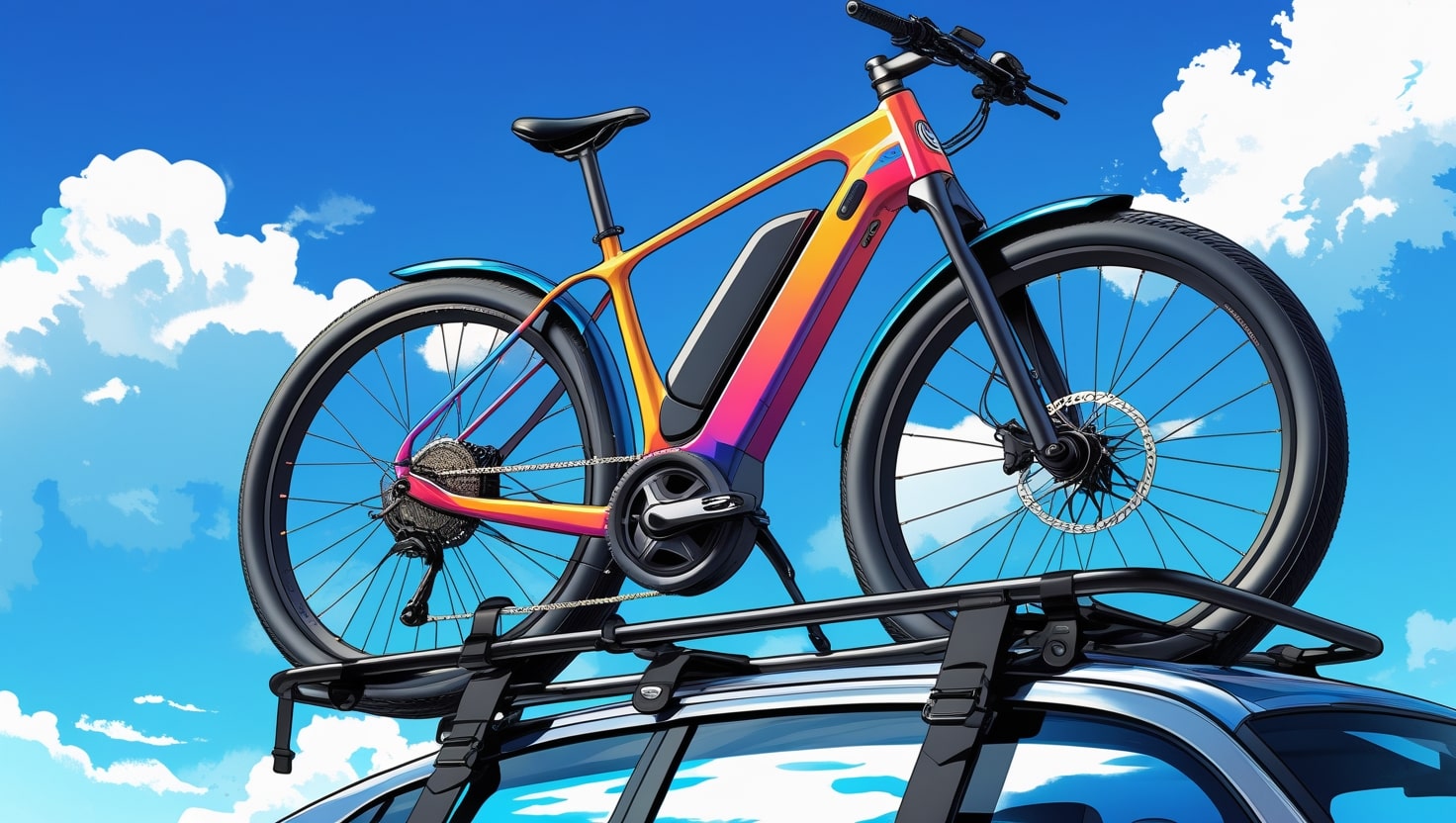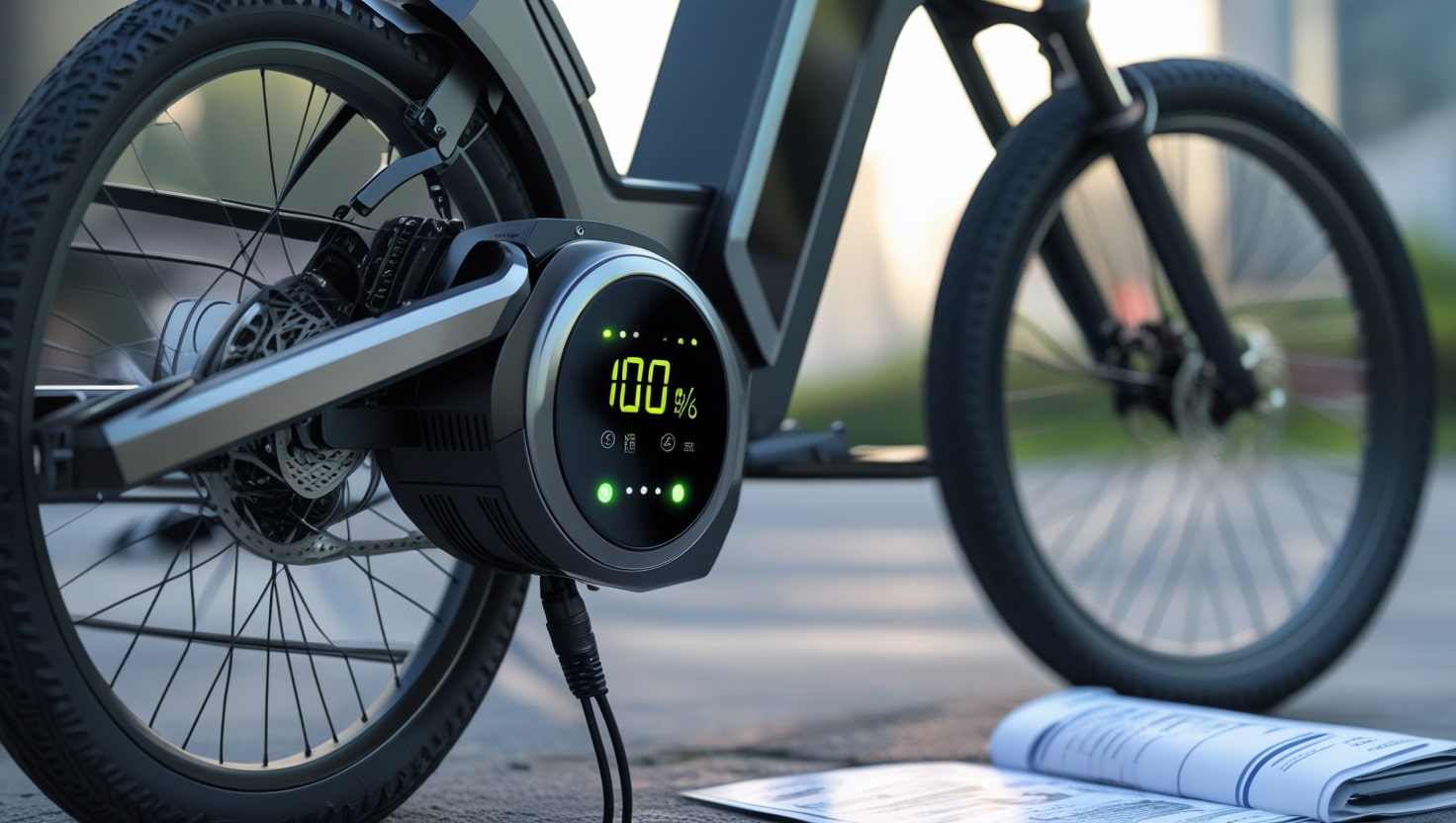When I first started exploring e-bikes, the choices felt both exciting and a bit challenging. With the rising popularity of electric bikes, more people are diving into the world of two-wheeled adventure—but the question remains: what’s the right tire for your ride? From my experience, deciding between fat tire vs regular tire ebike is more than just a visual preference—it’s about matching the type to your lifestyle.
As someone who’s tested each, I learned that investigating the subtle differences is crucial to making an informed decision. The advantages and disadvantages of both tires become clear once you understand the key aspects—terrain, weather, and speed.
If comfort and stability are high on your list of needs, a fat tire might suit you better. But for those looking for efficiency and lighter handling, a regular tire could be the smarter choice. At the end of the day, selecting what best suits your ride style means more enjoyable trips and fewer regrets.
Also Read: How Fast Does a 1000W eBike Go?
What are Fat Tire E-Bikes?
I’ve found that fat tires on e-bikes make a huge difference when riding on challenging terrains like sand or snow. These oversized tires, often 4 inches or more in width, are usually fitted on wider rims with a diameter of 20, 24, or 26 inches, giving them a larger surface area. This design improves traction and stability, especially under tough riding conditions. For outdoor enthusiasts like myself, the benefits are clear—you get a more versatile riding experience, which helps explain their growing popularity.
Benefits of Fat Tire E-Bikes
1. Improved Stability
In my early days of riding, I was a bit less confident, especially on loose surfaces like sand, mud, or snow. What helped me most was switching to fat tires. These tires cover a wider area, which means more traction and a better grip on unpredictable paths. Whether you’re riding over rocky terrain or tackling challenging obstacles off the beaten track, the enhanced stability fat tires provide is incredibly beneficial. They offer a steady feel that brings a real sense of security, especially when navigating through off-road environments on just two wheels. If you’ve ever found regular tires struggling in these spots, you’ll notice the upgrade right away.
2. Enhanced Comfort
One of the most surprising things I discovered is how the larger air volume in fat tires leads to a much smoother ride. With lower pressures, the tires act like a natural suspension, absorbing bumps and vibrations effortlessly. On difficult terrain, this cushioning effect is quite beneficial, and it also lessens rider fatigue on longer trips. For people with back issues or those who simply value comfort over speed, the built-in softness of fat tires creates a plush experience that’s hard to beat.
3. Versatility
As someone who likes to explore both on-road and off-road environments, I needed a bike that could handle various terrains without switching setups. Fat tire e-bikes give that exact flexibility. I’ve ridden through city streets, deep into forest trails, and across everything from dry pavement to icy paths without needing to stop. This seamless transition is what makes them a practical solution for adventurous cyclists. Because of their adaptability, they become a desirable choice for anyone who doesn’t want to be constrained by climate, weather, or terrain. With fat tires, you can enjoy year-round freedom in diverse settings.
Also Read: Can eBikes Go Up Steep Hills Easily?
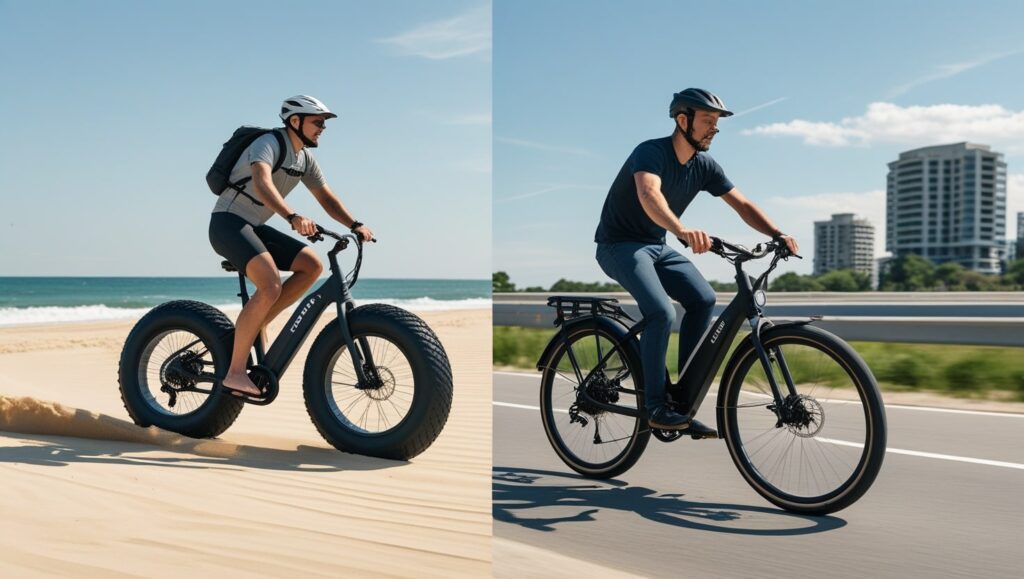
What Is a Regular Ebike?
When comparing a fat tire e-bike with a regular tire ebike, it’s clear that the traditional electric bikes offer a very different kind of ride. A lighter frame and thinner tires—usually with tire widths between 1.95 and 3 inches—make them perfect for urban settings and smooth city streets. From my experience, the lightweight construction gives better maneuverability, especially for daily commuting. These standard bikes are built for less demanding terrains and everyday biking, with designs that follow familiar patterns while keeping things agile and efficient.
Advantages of Regular Tire E-Bikes
1. Efficiency and Speed
When I began my daily commute using regular tires, the first thing I noticed was how little effort it took to ride. Thanks to the lower rolling resistance, I was able to ride at higher speeds while using less energy. The streamlined profile of regular tires improves aerodynamics, making urban riding on paved surfaces much more efficient. It’s clear why many commuters and riders looking to prioritize speed and performance choose this setup for their commuting needs. You simply cover more ground with ease.
2. Increased Range
Another benefit I’ve experienced is the extended range. Because of the reduced drag, regular tire e-bikes offer better range and conserve battery over longer periods. This becomes incredibly crucial when covering significant distances or relying on your e-bike for long rides between charges. Fewer charging cycles not only mean more time on the road but also a longer battery life, which ultimately boosts the lifespan of the bike. It’s a smart option for those who value dependable capability without constantly worrying about power.
3. Agility and Maneuverability
One reason I stick with regular tires in the city is their lighter and narrower profile, which makes the bike far more nimble. I can weave through traffic, make quick turns, and navigate crowded areas without stress. This kind of agility and responsive feel adds real confidence in tight spots. The reduced weight helps with acceleration, deceleration, and overall control, offering superior handling in fast-changing environments.
4. Cost-Effectiveness
From a budget angle, regular tires are incredibly cost-effective. They’re less expensive to replace and maintain, which is a big plus for people who ride frequently. Their wide availability means finding replacements or getting repairs done is much easier and less costly. The overall design of these e-bikes results in lower maintenance costs across many components, especially in urban settings. Over time, this leads to significant savings, making them a truly budget-friendly option in the long run.
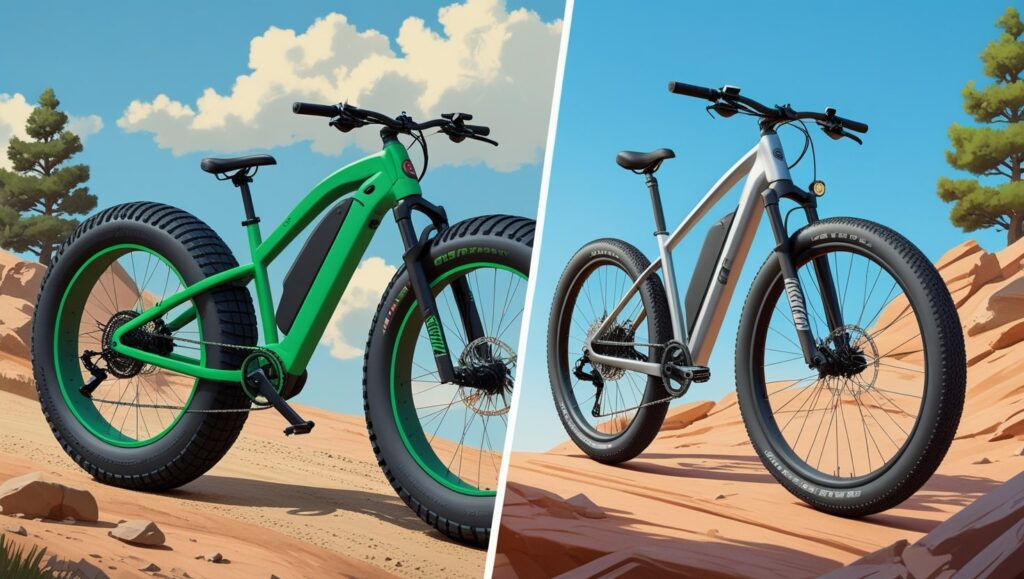
Choosing the Right Tire for Your Needs
Riding Environment: Based on my experience, urban commuters will often find regular tires the better choice when riding on paved roads or smooth bike paths. These tires offer excellent efficiency and performance in city settings where the terrain is consistent. However, for off-road adventures or more varied terrain, fat tires are ideal. They provide more control and grip, especially for off-road enthusiasts who need a more rugged e-bike for uneven paths and trails.
Weather Conditions: In areas with harsh winters, snow, or wet conditions, I’ve found that fat tires provide superior traction and become a significant advantage during challenging weather. They perform better when riding in extreme conditions. On the other hand, regular tires are great for typical urban and suburban environments, especially in dry weather where you don’t need extra grip but still want reliable handling and control.
Comfort vs Speed: If comfort matters more to you—maybe due to physical discomfort or just a preference for relaxed leisurely rides—then fat tires will give you a smoother ride. But if you’re one of those fitness enthusiasts or daily commuters who value speed, then regular tires are built for efficiency. This often depends on your primary purpose, and from what I’ve seen, personal preference plays a big role in making the final call.
Storage and Transport: In tight city living like apartments with space constraints, regular e-bikes are much lighter, easier to carry, and more practical to store. Their compact nature makes them suitable for multi-modal commutes, like hopping on public transportation or taking them up stairs. If storage space is limited, this becomes a crucial factor that often tips the scale in favor of regular tires when choosing your ideal transport setup.
Fat Tires vs. Thin Tires: A Detailed Comparison
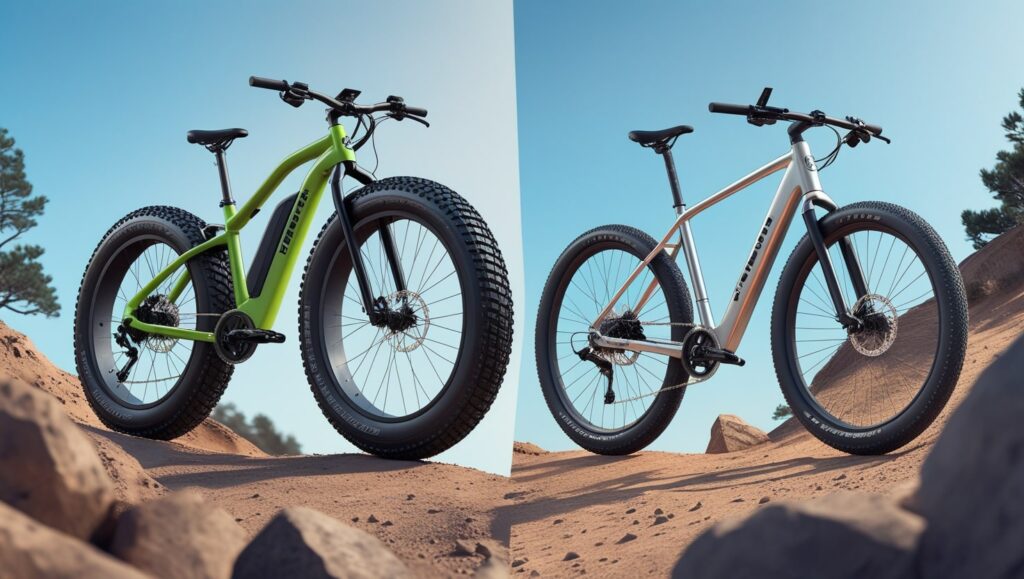
| Features | Fat Tires | Thin Tires |
|---|---|---|
| Tire Width | 3.8 to 5.0 inch | 1.5 to 2.5 inch |
| Top Speed | Lower | Higher |
| Rolling Assistance | Higher | Lower |
| Typical Pressure | 5-30 psi | 80-130 psi |
| Terrain | Rough terrain, snow, mud, gravel, sand | Smooth surfaces, paved roads |
| Shock Absorption | Higher | Lower |
| Traction | Excellent on all terrains | Lower on all terrains |
| Weight | 50-70 lbs | 40-50 lbs |
When to Choose a Fat Tire Ebike
Discover our selection of fat tire e-bikes, which are designed to be bold and durable while providing an amazing ride. These e-bikes are ready for anything and are perfect for a variety of activities and terrains.
Off-road enthusiasts: If you enjoy rough trails and backwoods paths, fat bikes with wide-fat tires are perfect. Their enhanced traction and stability help you ride over mud, snow, loose gravel, and sand with ease—ideal for true off-road enthusiasts who like to ride beyond pavement.
Commuters in challenging conditions: For daily commuting in cities with various road conditions, wider tires provide a more stable and comfortably controlled ride. I’ve found their capability in uneven conditions like potholes or curb jumps surprisingly effective when weather and roads are unpredictable.
Adventure seekers: If you’re into exploring different terrains, fat bikes are great for adventure riding. Whether it’s navigating rocky paths, rough terrain, or icy trails in snowy conditions, they handle it all without losing grip—built for those who want real riding freedom.
Beach cruisers: Riding along the beach is a whole different experience with fat bikes. Their large, wide tires glide over soft sand, making them the top choice for relaxed beach cruising. Based on my personal experiences, these beach cruisers are the best e-bikes for handling sandy areas.
2. Factors Affecting the Cost of Motorcycle Wrapping
It’s crucial to comprehend the main elements that will greatly affect the ideal features, specifications, and parts for your wants before making a fat tire e-bike purchase, including:
Motor power and torque: A powerful motor with high torque offers more assistance to the rider, especially when pedaling up steep hills or crossing challenging terrain. Choosing the right power level is key for overall ride efficiency and comfort.
Battery capacity and range: Look for larger-capacity batteries in fat-tire Ebike models—typically between 500 to 1200 watt-hours. This impacts your range, allowing you to ride 40-100 miles on a single charge, depending on the terrain, battery type, and your level of pedaling. Keep in mind that more capacity also means more weight.
Suspension system: A solid suspension setup is crucial when riding over rough or bumpy terrain. From my experience, front and rear suspension make a huge difference by delivering a smoother ride and reducing the impact on your body during off-road trips.
Frame size and geometry: The frame is the core of any bike, and getting the right geometry—including head tube angle, seat tube angle, and top tube length—can give you a perfect fit. These factors affect comfort, control, and overall strength of the ride. Making an informed choice guarantees that the bike will meet your requirements and standards.
Tire width and tread patterns: On soft terrains, wider tires with the proper width enhance both floatation and balance. If you want better maneuverability, thinner tires may be ideal. Aggressive or deep treads provide more grip on loose surfaces, slippery spots, and hard-packed trails, while smoother treads boost overall performance on stable ground.
Also Read: Electric Bike vs Hybrid Bike
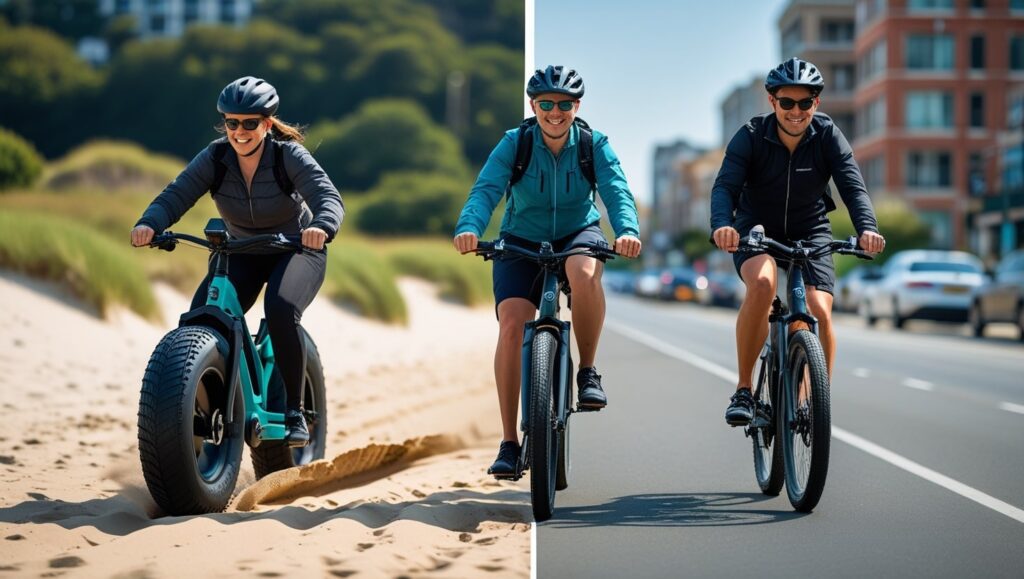
The Bottom Line
Choosing between a fat tire or thin tire electric bike comes down to your riding needs, terrain, and personal preferences. If you’re into exploring off-road terrains or want a more comfortable riding experience, a fat tire ebike might be the better option. However, a thinner tire can be more suitable and economical for your budget if you value speed and efficiency and primarily ride on paved areas. In my opinion, considering what truly fits your style and needs is the best decision, especially when those preferences directly shape how you enjoy every ride.
FAQs
Are fat tire Ebikes harder to pedal?
From my own rides, I’ve noticed that fat tire e-bikes can feel a bit more challenging to pedal, especially on flat terrain or smooth terrain. This is mainly because of the larger surface area and greater rolling resistance compared to conventional tires or narrower tires. But the good news is that the electric motor adds just the right balance, making it totally manageable for most riders, even if you’re new to heavier tires or different terrains.
Is it easier to ride a bike with fat tires?
In my experience, fat tires give you great stability and control, especially on tricky terrain like sand, snow, or rocky terrain. They’re ideal for riders who want a more safe and enjoyable riding experience, particularly when the path isn’t smooth. On the other hand, smaller tires can feel more effortless and effective when riding on smooth roads, especially if you’re aiming for speed. So, the real answer depends on your riding style—choosing the most appropriate tire can make your ride smoother, safer, and better suited to the conditions.
Which tires are faster on pavement?
If you’re mostly riding on smooth roads, then regular tires are your best bet for speed. From my own rides, I’ve noticed that they roll faster than fat tires because they have lower rolling resistance.
Also Read: How to Use CO2 Bike Tire Inflator
Do fat tires handle off-road better?
Based on my off-road rides, fat tires definitely offer better control because their wider contact patch greatly improves traction on tricky surfaces like sand, snow, and uneven terrain.
Will bigger tires drain my battery quicker?
In my experience, fat tire bikes with wider tires tend to use more power, especially on longer rides. This happens because the extra rolling resistance created by the large tire surface requires more effort from the motor. So yes.
Also Read:

